Double Star of the Month in Taurus
-
April 2025 - Double Star of the Month
With Arcturus riding high in the Spring sky, STF 1825 (14 16 32.84 +20 07 18.7) can be easily found as it is just 1.5 degrees north and a little west of the bright, orange giant star. The components have magnitudes 6.5 and 8.4 and the current separation is 4".4 so it is a relatively easy object for the small telescope.

A finder chart for the double star STF 1825 in Boötes created with Cartes du Ciel. The very slow orbital motion is reflected in the fact that my two sets of measures made in 1993 and 2019 show a difference in position angle of just 2 degrees. This is a relatively nearby system as the parallax determined by Gaia DR3 shows, the distance is 108 light-years and both stars are moving across the sky at more than 0.1 arc-second per year.
In Centaurus, near the border with Lupus, and about 9 degrees north and slightly west of Hadar (beta Centauri, V = 0.6) is HJ 4651 (14 09 35.03 -51 30 16.8), a wide and unequal pair of unassociated stars. The magnitudes are 6.0 and 8.9 and the current separation is 65". The primary star is the eclipsing binary V869 Cen and is almost four times nearer to the Sun than its fainter companion.

A finder chart for the double stars HJ 4651 and SLR 19 in Centaurus created with Cartes du Ciel. Of more direct interest but certainly a more difficult object is SLR 19 which is to be found 1.5 degrees north and a little preceeding HJ 4651. It is an almost equally bright pair which was first observed by R. P. Sellors in Australia using the 11.5-inch refractor at Sydney Observatory. The motion to date amounts to 45 degrees and an orbit by Izmailov gives a period of 415 years which predicts a closest separation of 0".6 in 2054. The predicted position for 2026.0 is 337 degrees and 0".9 and the magnitudes are 7.1 and 7.4.
Bob Argyle - Double Star Section Director
-
March 2025 - Double Star of the Month
The spectral type of the primary of STF 1689 (12 55 30.32 +11 29 46.4) is given as M4III in the Washington Double Star catalog (WDS). One might expect to see a deep-orange, or red star but observations of the pair in the literature seem to indicate that the primary colour reflects an earlier spectral type.
T. W. Webb notes yellowish, whilst Admiral Smyth recorded pale white. All three observers noted that the companion was blue or bluish. More recently, I recorded orange and blue using a 10-inch reflector at x96 in 1970. Sissy Haas gives peach-white, and a note on TheSkySearchers website records colours of orange and bluish.
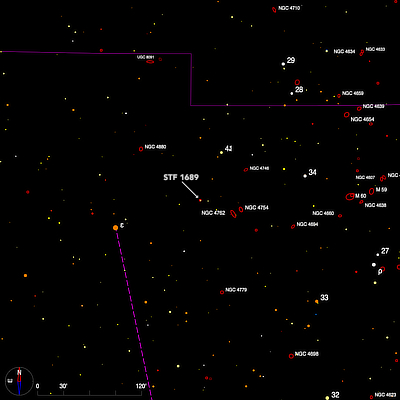
A finder chart for the double star STF 1689 in Virgo created with Cartes du Ciel. Gaia has observed both components and the stars are unrelated. The primary is 960 light-years away whilst B is 474 light-years distant. The components are slowly separating due to the different proper motions and in 2019 the relative position was 222 degrees and 30".3. The pair can be found 2 degrees NNW of epsilon Virginis.
R 213 (13 07 24.30 -59 51 37.8) was discovered in 1874 by Henry Chamberlain Russell. Russell was the Government Astronomer at Sydney Observatory from 1870 until 1905. He was using a 11.5-inch refractor made by Schröder to carry out a survey of some of the John Herschel double stars which the latter discovered at the Cape. It was one of the most difficult of his discoveries being found at 207 degrees, 0."3. His description of the stars was
a very beautiful double star - both alike and orange coloured
.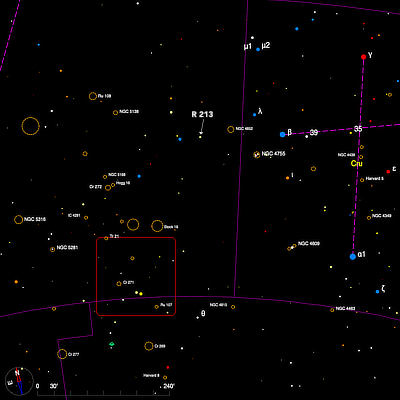
A finder chart for the double star R 213 in Centaurus created with Cartes du Ciel. When I observed the pair in 2016 using the 67-cm refractor at Johannesburg, the PA was very similar but the distance has increased to almost 0".8. With WDS magnitudes of 6.6 and 7.0, the pair should be divided in 15-cm. R 213 lies in Centaurus close tothe border with Crux and can be swept up by moving 2.5 degrees due east from beta Crucis (Mimosa), which is DUN 125 - magnitudes 1.3, 7.2, 23 degrees, 373" - a fine binocular double.
Bob Argyle - Double Star Section Director
-
January 2025 - Double Star of the Month
About five degrees east of the line joining the two stars which form the 'horns' of the constellation of Taurus, the Bull is a right-angled triangle of 5th magnitude stars. These are 132, 136 and 139 Tauri. If you acquire 132 Tau in the field then about 20 arc-minutes north-east is the wide pair STTA66 (05 47 56.13 +24 41 12). This is an entry in the catalogue of wide pairs which Otto Struve compiled during his survey at Pulkovo in the 1840s.

A finder chart for the double star STTA 66 in Taurus created with Cartes du Ciel. The stars, which are relatively bright - 7.0 and 7.7 - and are separated by 94" in position angle 166 degrees. Rather surprisingly, they appear to be at the same distance as determined by the Gaia satellite and a search around them reveals a star of magnitude 19 also at that distance although the quoted error is substantial.
132 Tauri itself is recorded in the Washington Double Star catalog (WDS) as a very close visual binary, although only observed on one occasion in 1979. During the Hipparcos survey another component was recorded. The two stars were given as 5.0 and 9.1 at 230 degrees and 3".8. And again the only observation appears to be the first one and such a pair should be visible in 25-cm (the WDS gives magnitudes 5.0, 9.1, 230 degrees, 3".8). It certainly it should have been detected in the recent Gaia observations and does not appear there.
Looking through the earlier entries in this column which occupy the southern sky I find that I have been remiss in not including one of the finest of John Herschel's pairs - HJ 3945 or 145 CMa (07 16 36.84 -23 18 56) known quite widely, especially in the United States, as the 'Winter Albireo'. The stars are not quite bright as those in beta Cygni but form a spectacular pair for the small telescope.

A finder chart for the double star HJ 3945 in Canis Major created with Cartes du Ciel. The primary is a K3 supergiant and its companion an F0 dwarf. John Herschel notes
Orange and green. Fine contrast of colours
. Modern observers also attest to the strong contrast of colours.This is certainly an optical pair - star B is 346 light years away whilst star A is 2,600. The stars can be found 3 degrees east of the magnitude 3.0 blue supergiant omicron 2 CMa. The 6th magnitude star HIP 35578 which is more than 3 degrees to the south and has almost identical proper motion to B has been formally identified as a physical companion (C). However Gaia DR3 gives its distance as 296 light-years - about 50 light-years closer than B.
Bob Argyle - Double Star Section Director
-
December 2024 - Double Star of the Month
STF 430 Tauri (03 40 28.04 +05 07 33.2) is a coarse and unequal triple star found 1.5° WSW of 29 Tauri. The AB consist of stars of visual magnitude 6.8 and 9.8 separated by 26" at a PA of 57 degrees.
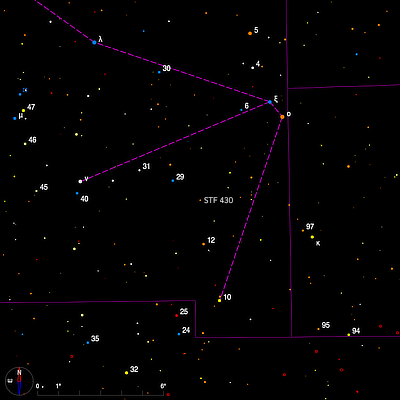
A finder chart for the double star STF 430 in Taurus created with Cartes du Ciel. The primary is a K2III and appears distinctly orange in the eyepiece. An observation made with a 10-inch mirror at x48 showed that B is blue as is the further companion, C, which is 34" away and is somewhat fainter than B.
Although A and B have similar parallaxes they are not the same within the errors quoted in the Gaia DR3 catalogue, and actually the faintest star is much closer to us than the other stars.
In southern Eridanus near the border with Caelum lies 41 Eridani (04 17 53.62 -33 47 54).

A finder chart for the double stars 41 Eridani and HJ 3642 in Eridanus created with Cartes du Ciel. This is a star which has an unusual chemical composition which contains significant amounts of mercury and manganese. Such stars are found to be common in spectroscopic binary systems and in 2012 a team using the VLTI in Chile resolved 41 Eri into two with a period of 5 days and a separation of a few milli-seconds of arc.
A century before, however, Robert Innes, using a 7-inch refractor from the Cape of Good Hope, found the star to be a close double bright (I 270) with magnitudes of 3.6 and 4.
The pair began to close in and were last seen in 1933 when the distance was 0".1. Later attempts to resolve the stars have failed - between 2017 and 2019, Dr. Andrei Tokovinin was unable to see the companion using a 4-metre telescope and it is now supposed that this is not a visual double star.
In 1836 John Herschel found a faint companion (HJ 3636 AC) about 60" distant and gave the magnitudes as 3 and 14. Today the WDS gives magnitudes of 3.9 and 11.8 with PA and separation of 8 degrees and 49".
Whilst in the area check out another HJ pair, no. 3642 just a few arc-minutes SSE - 6.6, 8.7, 157 degrees, 5".2.
Bob Argyle - Double Star Section Director
-
January 2024 - Double Star of the Month
Admiral Smyth's Bedford Catalogue contains an entry for 124 Tauri, and from his description of it as a coarse quadruple star of which components B and C are 6".2 apart in PA 318 degrees this appears to agree with Struve's catalogue entry of STF 755 (05 39 09.17 +23 17 17.7).
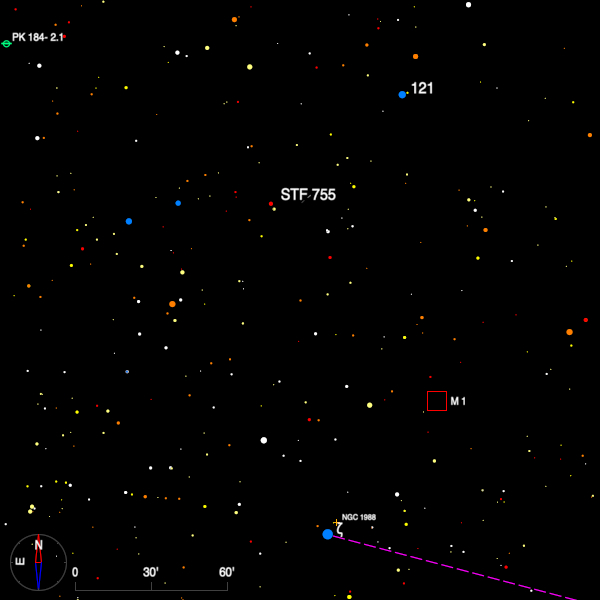
A finder chart for the double star STF 755 in Taurus created with Cartes du Ciel. According to the Washington Double Star catalog (WDS) A is magnitude 7.8 at 31 degrees and 149". This is HD 37387, a K2 giant star which appears close to the reflection nebula GN 05.36.2.The fourth star, D, is 50 degrees and 95" from A and has V = 11.1.
There is no label for 124 Tauri in the the Cambridge Double Star Atlas (2nd edition) but the star appears about 30' W of a small right-angled triangle of 6th magnitude stars which in turn sits 2 degrees NNE of zeta Tauri. Smyth happened upon it in 1835 whilst looking for Comet Halley. He gives the colours as garnet (A), pale blue-white (B,C) and bluish (D).
Some 3.5 degrees WSW of epsilon CMa is a triangle of 5th and 6th magnitude stars, the brightest of which is 10 CMa. In the same field, north following is HJ 3891 (06 45 31.20, -30 56 56.3), a double star discovered by John Herschel from the Cape of Good Hope.
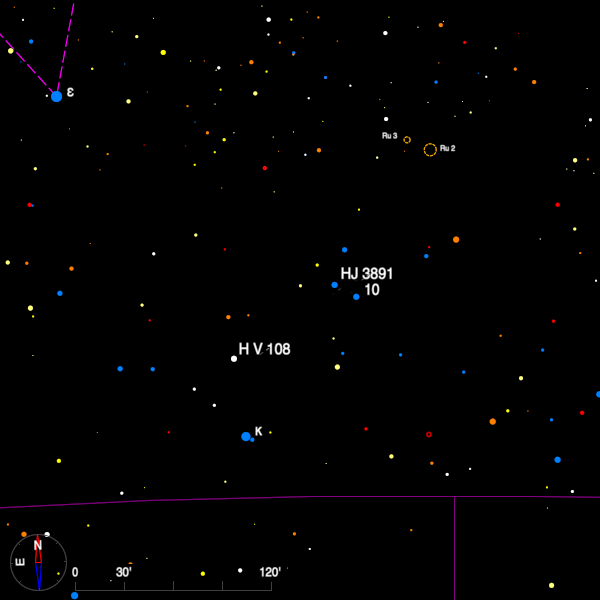
A finder chart for the double star HJ 3891 in Canis Major created with Cartes du Ciel. The primary is a B2III star of V = 5.7, and is accompanied by a 8.2 magnitude star at 223 degrees and 5".0. There has been little change since 1838. The stars have similar parallaxes and the mean distance to the system is 1968 light-years. The primary star is also called HP CMa.
Just 90 arc-minutes to the SE is a wide pair swept up by the elder Herschel in 1782. H V 108 has stars of similar brightness (5.8 and 7.7) but they are separated by 43" in PA 66 degrees. The A component has a particularly close and faint companion just 0".6 away which was discovered from Robert Rossiter in South Africa, whilst the WDS notes that the B star has a variable radial velocity. Andrei Tokovinin regards this as a physical quadruple - the brighter stars appear in Gaia DR3 with respective distances of 634 and 623 light-years.
Bob Argyle - Double Star Section Director
-
December 2023 - Double Star of the Month
About 4 degrees south-west of zeta Tau, is a coarse group of faint naked-eye stars, the brightest of which is 119 Tau, a red supergiant with V = 4.3. One and a half degrees WSW of 119 is 115 Tau, but between the two lie a couple of visual double stars.
Nearest 119 Tauri is HJ 3275 (05 29 49.77 +18 24 58.3) which is a good target for a small aperture - Sissy Haas notes that they are
a beautiful sight for an 8 x 50 finderscope
. The stars have magnitudes 7.7 and 8.2 and they are separated by 56" in PA 21 degrees, and are physically unassociated.
A finder chart for the double stars HJ 3275 and STT 108 in Taurus created with Cartes du Ciel. Both S. W. Burnham and R. G. Aitken have visited this system and added faint and close companions to both stars. In the case of A (= BU 891) it is a magnitude 12.6 star at 10".6 whilst for C (= A 2433) it is a 12.0 star at 1".4.
A few arc-minutes preceding the A star is STT 108, a discovery by Otto Struve at Pulkovo. In this case the stars are magnitudes 6.7 and 10.4 and separated by 3".2 in PA 131 degrees so they should be visible in 15-20 cm.
The constellation of Mensa is not well-served for visual double stars, in fact this is the first entry for this constellation since the series began in 2006! The Cambridge Double Star Atlas lists only four entries, the brightest of which is HRG 2 (05 01 09.45 -74 20 27.1).
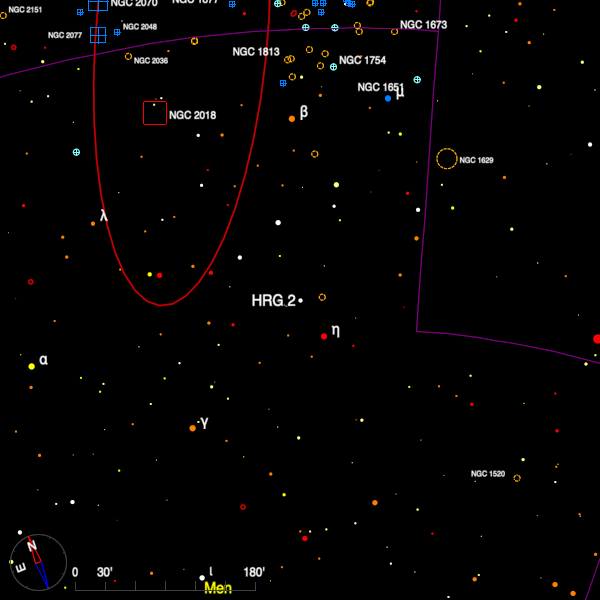
A finder chart for the double star HRG 2 in Mensa created with Cartes du Ciel. The discoverer name was entirely unknown to me. HRG is the label given to several dozen discoveries by Lawrence Hargrave from Sydney Observatory around 1880. Hargrave was born in Greenwich in 1850 and ended up as an assistant astronomical observer to H. C. Russell in Sydney. He is better known as an aviation pioneer and invented the box kite, a manned version of which he flew to a height of 16 feet. He died in Sydney in 1915.
HRG 2 is a close pair which needs 15-cm and has remained at a separation of 0".8 since its discovery. The stars have magnitudes 7.4 and 8.0. This is a distant system - Gaia gives a parallax of 3.83 mas for the A component corresponding to a distance of 851 light-years.
Bob Argyle - Double Star Section Director
-
December 2022 - Double Star of the Month
47 Tauri = BU 547 (04 13 56.39 +09 15 50) could be be described as a typical Burnham discovery. The stars are both unequal and close, a type of visual binary that Burnham seemed particularly adept at finding.
The V magnitudes are 5.1 and 7.3 and at present they are 1".3 apart in position angle 339 degrees. They have moved slowly apart since discovery and seem likely to continue this trend for some years to come.
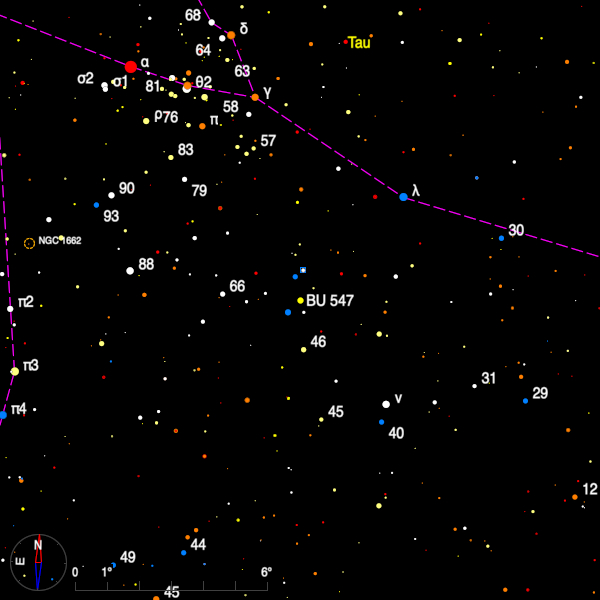
A finder chart for the double star BU 547 in Taurus created with Cartes du Ciel. Hipparcos determined a parallax of 9.83 mas for the whole system whilst Gaia DR3 contains only the results for the primary star. This comes in at 7.96 mas.
I was able to measure the pair on 2 nights in 1993 using the 8-inch Cooke refractor at Cambridge Observatories, but it was not an easy object. 47 Tau is about 8 degrees south-west of Aldebaran and sits in a low power field with magnitude 4.3 mu Tau. A good 6-inch should show the stars which have been allocated a preliminary orbit of 479 years.
The Washington Double Star (WDS) catalogue also lists an unassociated field star of magnitude 13 which is at 228 degrees and 28".
SKF 949 (03 53 33.33 -46 53 37.2) came to the attention of Brian Skiff at Lowell Observatory whilst examining stars in Nancy Houk's spectral type reclassification project in order to add to his extensive collection of spectral types.
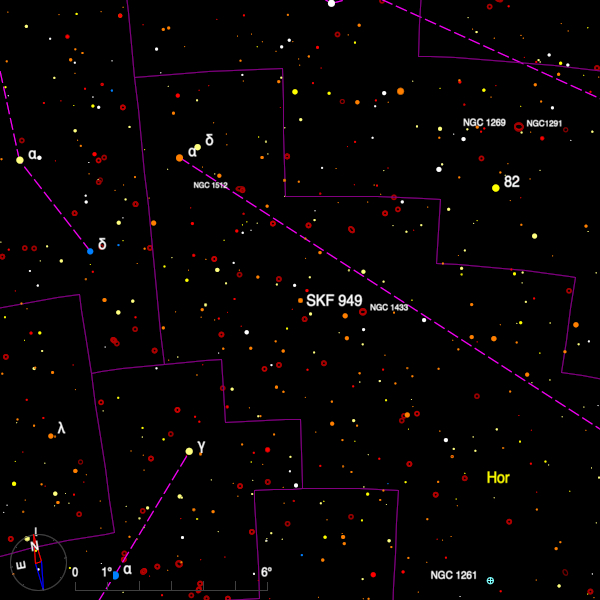
A finder chart for the double star SKF 949 in Horologium created with Cartes du Ciel. Examination of Vizier showed a common proper motion companion, V = 8.5 and spectral type G, some 76" distant from the K2III primary which has V = 6.1. and which is almost due south of its companion. Gaia DR3 confirms that the stars have similar parallaxes, indicating that they are 359 light-years distant.
This is an easy pair for the small telescope and may even be visible in a pair of suitable binoculars. The system is in a unremarkable area of Horologium, about 6 degrees south-west of alpha.
Bob Argyle - Double Star Section Director
-
March 2022 - Double Star of the Month
15 Boo (14 14 50.85 +10 06 02.2) is a naked-eye star about 9 degrees due south of Arcturus. Discovered as a close double by Gerard Kuiper in 1936, it has shown little motion since that time. I measured it on 3 nights in 2001 using the 8-inch Cooke refractor at Cambridge and got a relative position of 119 degrees, 1".1. The Washington Double Star Catalog (WDS) indicates that in 2015 the position was 111 degrees and 0".8.
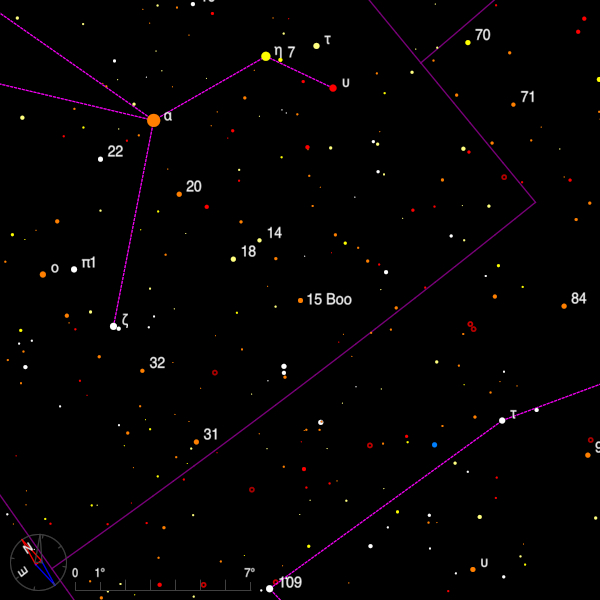
A finder chart for the double star 15 Boötis created with Cartes du Ciel. The difficulty of resolving this pair is exacervated by the difference in magnitude between the components: 5.4 and 8.4. In 2020, Dr. Marco Scardia using the 1-metre Epsilon telescope at the Plateau de Calern near Nice, found that B was itself a close visual pair: 8.4, 10.0, 175 degrees, 0".2.
In an area just north of a line drawn between theta and iota Centauri there is a rich profusion of visual double stars. One of the more interesting is HWE 28 (13 53 32.75 -35 39 51.2) a binary whose components shine at magnitudes 6.3 and 6.4. The period is 363 years and at the present time the stars are 1" apart in PA 317 degrees. An 8.7 magnitude star lies 68" away in PA 7 degrees and two much fainter stars can be seen - a 12.3 at 150 degrees 28" and a 14.8 at 133 degrees 38".
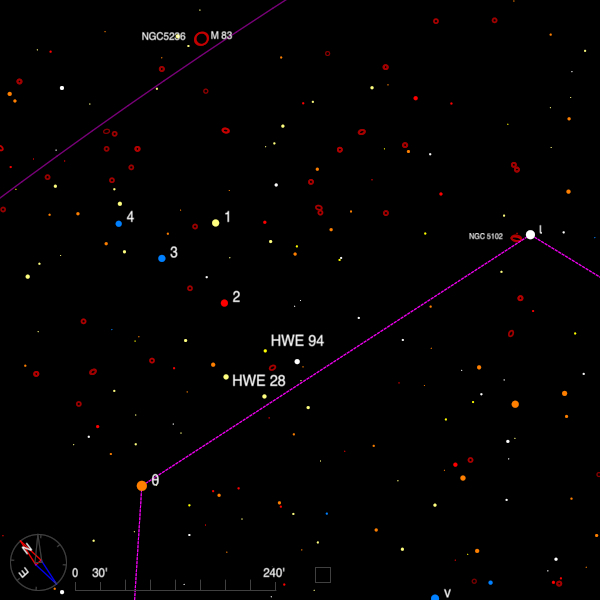
A finder chart for the double star double stars HWE 28 and HWE 94 in Centaurus created with Cartes du Ciel. Just 1 degree due west is HWE 94 (13 48 55.07 -35 42 15.1) where the components are 6.6 and 10.2 and the separation 12" in PA 0 degrees. The HWE stars were found by Herbert A Howe, who started his career at Cincinnati Observatory, and went on to become Director of the Chamberlin Observatory which was attached to the University of Denver, Colorado. It boasted a 20-inch Clark refractor.
Bob Argyle - Double Star Section Director
-
January 2022 - Double Star of the Month
phi Tauri (04 20 21.2 +27 21 03) can be found about 10 degrees north of the Hyades. Found by William Herschel, it is an attractive double star for small apertures, offering as it does, a beautiful colour contrast between the two components. The primary is a K1 giant which W. H. Smyth found to be pale red but I noted as golden yellow with a 21-cm mirror in 1968. The companion is blue and the stars are magnitudes 5.0 and 7.4.
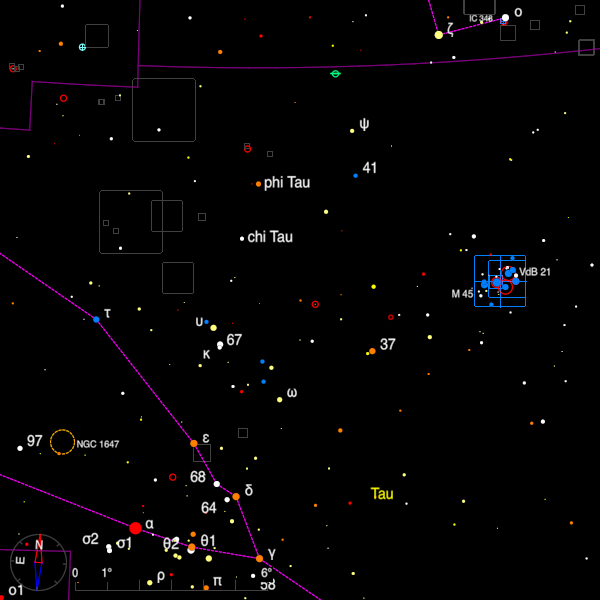
A finder chart for the double stars tau and chi Tauri created with Cartes du Ciel. I found the position angle (PA) and separation to be 258 degrees and 48".4 in 2015 and whilst this is significantly different to the first measures of this pair, the differences are due entirely to differences in proper motion due to the differing distances to each star; 284 light-years for the primary, and 346 light-years for the secondary.
Just 2 degrees south, and slightly east of phi is chi (04 22 34.9 +25 37 45), another probably optical pair, but with magnitudes of 5.4 and 8.5, it is also well-seen in small telescopes. The stars are separated by 19" in position angle 25 degrees.
The 4.4 magnitude tau (or 30) Canis Majoris (07 18 42.49 -24 57 15.8) is at the centre of the open cluster NGC 2362. Like many stars in this region it is young, hot and very luminous and has a spectral type of 09II.
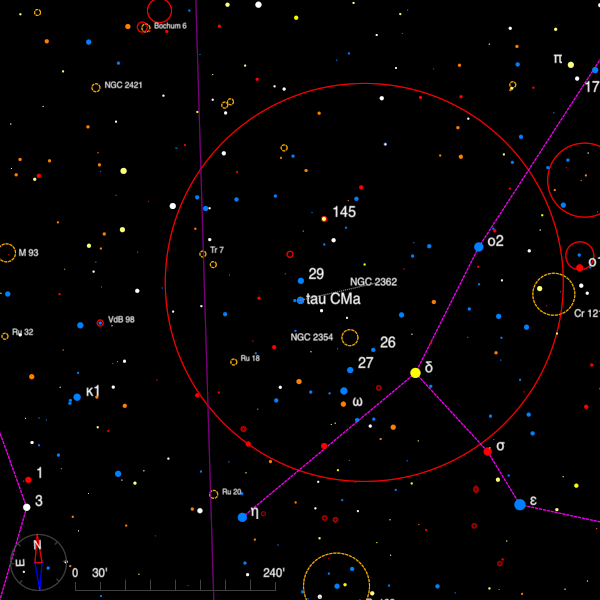
A finder chart for the double star double star tau Canis Majoris created with Cartes du Ciel. It attracts the interest of the double star observer because it appears in the catalogue of John Herschel as HJ 3948. The nomenclature applies to companions of 10.2, 11.2 and 8.2 at distances of 8".3, 14".2 and 83".5 respectively and it is of interest to the binocular observer as well as the small aperture telescope.
Tau itself, has 5 components all within 1 arc-second. Quite recently, Dr. Andrei Tokovinin found a magnitude 9.7 star nestling 0".9 away whilst in 1951, the great interferometric observer William Finsen noted another star 0".2 distant. Tau is also a tight triple star with a fainter eclipsing binary, orbiting tau itself as a spectroscopic binary with a period of 154 days.
Bob Argyle - Double Star Section Director
-
December 2021 - Double Star of the Month
STT 65 (03 50 18.9 +25 34 47) is close visual pair about 2 degrees north-east of the Pleiades but which does not appear to be part of the cluster. Although the compilers of Gaia EDR3 decline to pronounce on the value of its parallax, the Hipparcos mission found it to be less than half the distance to the Pleiades at 184 light-years.

A finder chart for the double star STT 65 in Taurus created with Cartes du Ciel. The pair was discovered by Otto Struve using the 15-inch refractor at Pulkova in the 1840s and it has been followed regularly ever since the orbital period was found to be relatively short (it is currently thought to be 61 years). The orbit is highly inclined and quite eccentric which means that the apparent distance between the stars ranges from 0".03 (in 1996) to almost 0".7 in 2033. At the end of 2021 the stars will be 0".59 apart and thus within range of a good 20-cm aperture, although there is a significant difference in magnitudes between A and B - 5.7 and 6.5 respectively.
Located in the narrow part of Eridanus which squeezes between Fornax and Horologium, is the K giant star y Eri (magnitude 4.6). Half a degree east is the fine pair DUN 15 (03 39 45.49 -40 21 08).
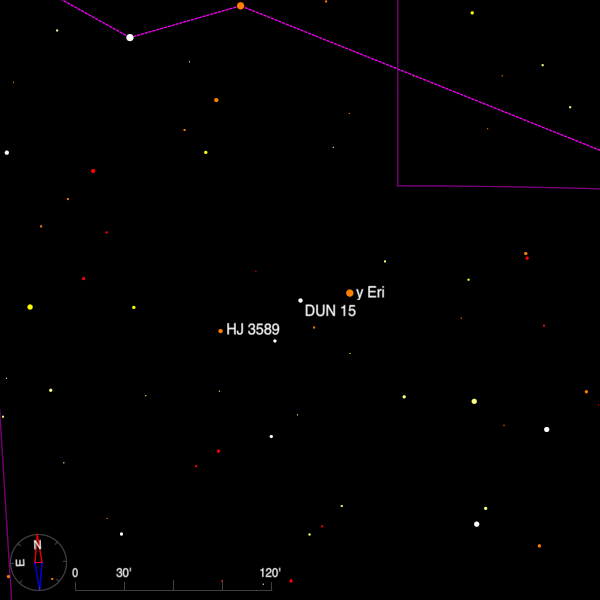
A finder chart for the double star DUN 15 in Eridanus created with Cartes du Ciel. Since John Herschel's measure in 1836, the distance has increased from 4".0 to 7".5 at the current time, whilst the position angle has reduced from 335 degrees to 327 degrees. The stars are both of spectral class A and the Washington Double Star Catalog (WDS) gives the V magnitudes as 6.9 and 7.7. This does seem to be a physical pair as the Gaia EDR3 catalogue lists a parallax for each star which is the same (mean value 4.70 mas = 694 light-years) within the errors.
Moving 1 degree ESE from DUN 15 will bring the observer upon HJ 3589, an unequal pair of magnitures 6.5 and 9.3 with position angle 350 and a current separation of 5".0 but which appears to be slowly decreasing.
Bob Argyle - Double Star Section Director
-
May 2021 - Double Star of the Month
1 Boötis (13 40 40.50 +19 57 20.4) is a star just about visible to the naked eye on a good night. It can be found about 4 degrees WNW of eta Boötis. It is not an easy double star for the small aperture and I have not actually observed it, even thought the primary is a naked-eye object.
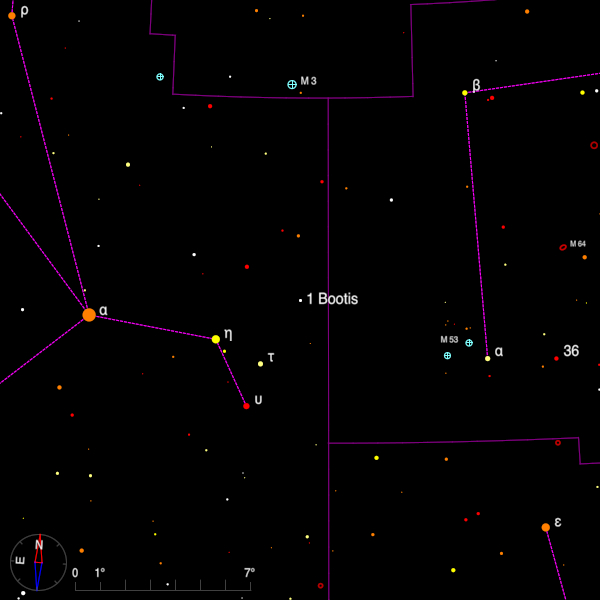
A finder chart for the double star 1 Boötis in Boötes created with Cartes du Ciel. The Washington Double Star Catalog (WDS) gives the magnitudes as 5.8 and 9.6 with the current position angle and separation being 133 degrees and 4.4 arc-seconds. A 15-cm aperture should give a good view of the stars, the primary being white - its spectral class is A1V. There is a faint field star, magnnitude 12.2, 88 arc-seconds away whilst the 7.4 magnitude star at 208 arc-seconds has a similar parallax and proper motion as the stars of the binary. According to Gaia EDR3 the three lie at a distance of 310 light-years.
For the first time in this series, (as far as I know, and deliberately at least!) a binary star is going to be included a second time. This is because it is an exceptional object, about which much has been learned recently so it seems a good time to take another look at alpha Centauri (14 39 36.50 -60 50 02.3).
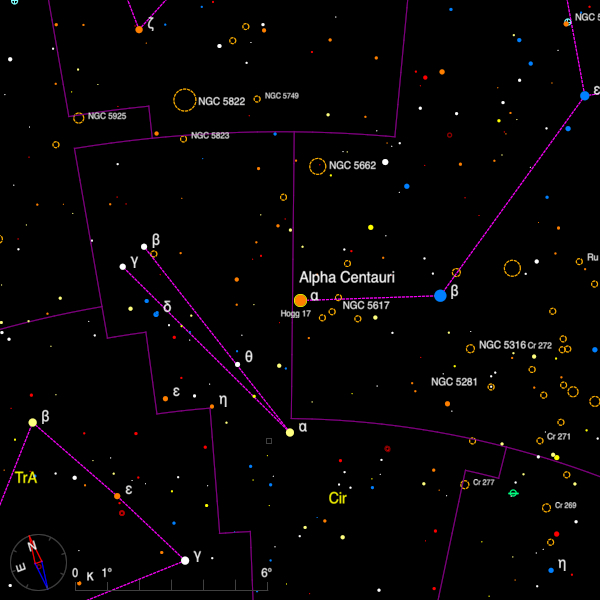
A finder chart for the double star alpha Centauri in Centaurus created with Cartes du Ciel. In May 2007, alpha Cen was at PA 235 degrees and 8".4. This month it can be found at 354 degrees and 6".35, although it is now widening, but only as far as 10".4 in 2020, and then it closes to 1".7 in 2038. Extensive direct imaging has been done of both the stars in the bright binary and the physically connected Proxima Centauri.
To date there definitely seems to be one planet orbiting Proxima and recent observations suggest there is a second one. Both bright components have been suspected of having planetary companions and a recent paper purports to show a candidate close to the A component.
The latest data from the Gaia mission - data release EDR3 - includes a measurement of Proxima Centauri. The satellite finds the star to be 4.2465 light-years away with a quoted error of 0.0003 light-years. The main stars are far too bright to have been considered for data reduction at present though it is hoped that this might be done towards the end of the present mission.
Alpha Centauri is always a 'goto' object for the observer fortunate enough to be south of latitude +20 degrees or so. I have seen the stars in the 67-cm refractor at Johannesburg, and they appear like car headlights - dazzlingly bright.
Bob Argyle - Double Star Section Director
-
January 2020 - Double Star of the Month
118 Tau (= STF 716) is well-placed for observing in mid-evening (RA 05 29 16.49 +25 09 01.1) and can be located almost half-way between the stars forming the points of the 'horns' of Taurus, (zeta and beta Tauri).
It is a distinctly neat pair for the small aperture - 10 or 15 cm will show it very well. First noticed by Herschel (H 2 75) this pair of B and A type dwarfs appeared white and pale blue or white and bluish to the early observers.
With little change of separation over 200 years (it is currently 4".7) the position angle has increased by 27 degrees to its current value of 210 degrees and Gaia DR2 shows that the parallaxes of the components are similar but not identical, being 8.96 mas ± 0.10 mas for the magnitude 5.8 A, and 8.42 ± 0.12 mas for B (magnitude 6.7).
In late 2002 Roberts and colleagues found faint companions to both A (at a distance of 1".7) and B at a distance of 1" but no confirmatory measures have yet been made. There is a 11.9 magnitude field star 140" away in PA 99 degrees.
The constellation of Lepus is unfortunately low in the sky for UK observers but repays some attention as there are attractive double stars to be found, especially if the seeing is good.
38 Leporis (RA 05 20 26.91 -21 14 23.1) is 2 degrees WSW of beta Leporis and was discovered by John Herschel (HJ 3750) from the Cape in November 1835 with the comment
A most beautiful double star
.The magnitudes are 4.7 and 8.5, whilst the stars appearing to be slowly widening. In 2015 they were at 279 degrees and 4".0. Observing from Victoria in Australia, Ernst Hartung found them pale yellow and white, as did Sissy Haas adding
easily seen with 75-mm
.If the seeing is good then try beta Lep itself. This Burnham pair is magnitude 2.9 and 7.5 at 8 degrees, 2".7 substantially different from the discovery PA 268 degrees indicating significant orbital motion. Gaia DR2 appears to show a third component with G mag 8.68 (similar to V) at a distance of 1".3 which may be new.
Bob Argyle - Double Star Section Director
-
May 2019 - Double Star of the Month
BU 800 (13 16 51.05 +17 01 01.9) was re-discovered in 1881 using the 15.5-inch refractor at Washburn Observatory by Burnham who recorded a separation of 1".27 in position angle (PA) 121.5 degrees, with estimated magnitudes of 7.1 and 10.2. In fact Herschel had found it almost a century earlier and catalogued the system as H 2 46.
Burnham noted
This is a very interesting physical system
. By 1898 the separation had doubled with little change in angle leading Burnham to suspect that it was an orbital pair with the plane in the line of sight. By 2015 the stars were 7".7 apart and, according to the 770 year orbit of Hale (1994), they should start to close around 2040.Hale's orbit suggests that the inclination of the plane to the line of sight is 93 degrees; almost edge-on. Gaia DR2 confirms that they are close together in space at distances of 35.83 light-years (A) and 35.80 light-years (B), respectively. That evidence plus the relatively large and similar proper motions confirms that this is a long period system.
For the small telescope user this will be a challenge. The modern magnitudes are 6.7 and 9.5 but 12.5-cm suffices to see the stars which are orange and red in colour according to Hartung. Haas notes that it is 40 arcmins south of the globular NGC 5053. Recent observations with the CHARA array using baselines of 331 metres show no close companions to A.
Zeta Centauri, a V=2.6 magnitude B star, forms an equatorial triangle with alpha Cen and beta Cru. A wide-field view of zeta will also include two double stars, one 0.5 degrees SW, HJ 4619 (13 52 02.91 -47 51 56.6) and another 1 degree SW, CPO 61 (13 51 32.35 -48 17 35.7).
Both are easy for the small telescope. HJ 4619 was noted by John Herschel on July 2nd, 1834 on Sweep 434 without comment apart from a note on the position angle and separation. It transpires that these stars are unrelated - Gaia DR2 notes that the V=6.9 magnitude primary is 748 light-years away whilst its V=8.4 companion is only 208 light-years away. The error on the DR2 parallax for this star suggests a higher multiplicity. I measured them at 198.3 degrees, 23".24 in 2016.
CPO 61, on the other hand, (7.4, 7.4, 130.6 degrees, 30".59, 2016) is almost certainly a binary pair. The slightly brighter primary is slightly closer (222.0 light-years) compared to the B star at 223.4 light-years.
Bob Argyle - Double Star Section Director
-
May 2017 - Double Star of the Month
24 CBe (12 35 07.76 +18 22 37.4) sits just on the northern edge of the Coma Cluster of galaxies and about 10 degrees to the south of the coarse open cluster of stars in Coma.
It is a fine pair for the small aperture and well worth looking for. The different spectral types of K2III and A9Vm promise a substantial colour contrast. Smyth notes
A, 5.5 orange colour, B 7 - emerald tint,- the colours very brilliant
. Hartung, from Australia finds deep yellow and white, whereas Sissy Haas records citrus orange and fainter royal blue.The WDS gives the visual mags as 5.1 and 6.3. Hipparcos gives similar proper motions but differing parallaxes - 7.24 mas for A and 19.29 for B but the latter comes with an error of +/-14.58 mas possibly due to the fact that this star is known to be a spectroscopic binary (SB). The relative positions are very useful for calibration purposes. At present the PA and separation are close to 270 degs and 20".
Starting at beta Crucis and moving eastwards by about 3 degrees will bring you to a pair of barely naked-eye stars separated by about a degree in right ascension.
The first of these is the fine pair R 213 (6.6, 7.0, 22 degs, 0".7) whilst the second is the multiple star I 424 (13 12 17.63 -59 55 13.9). To the user with 15-cm or more, here is an unequal pair of stars of mags 4.6 and 8.4, separated by 2". This has opened slightly and moved 20 degrees in increasing PA since being found by R.T.A. Innes.
Two fainter and wider companions are also catalogued. C is mag 12 at 258 degs, 46" whilst D, a much greater test, is mag. 14.9 at 24 degs and 53".
Whilst in the neighbourhood, about 7' north-east is the wide pair COO 152 (mags 6.2, 9.4, 146 degs, 25").
If you are able to bring 50-cm aperture to bear then there are two further tests. I 424 A is the close binary SEE 170 - currently at 0".17 and with a period of 27.4 years; the mags are 5.3 and 6.2. One of these stars is also a SB - actually an eclipsing beta Lyrae-type system.
The A star of COO 152 was resolved by Hipparcos. The components of this system are 6.4, 9.7 and the separation is 0".4. One of these stars is a SB of 4.23 day period and the 25" component is also physical meaning that COO 152 is a quadruple system.
Bob Argyle - Double Star Section Director
-
May 2015 - Double Star of the Month
STF 1694 (12 49 13.80 +83 24 46.3) is one of the most northerly of the bright double stars and lies in a rather sparse area of the sky. It is worth making the effort to find it as the planetary nebula IC 3568 lies 1.5 degrees south-west. Both stars are in the Hipparcos Catalogue and though the parallaxes seem significantly different (8.14 mas for A and 5.57 mas for B), the large error on that of B means that they are the same within the quoted uncertainties. However, B is a spectroscopic binary and this may well account for the Hipparcos satellite's problems with defining its distance accurately. The primary star (V = 5.3) is an A1 giant whilst the companion (V = 5.7) consists of a pair of A0 and A2 dwarfs. The current position angle and separation is 324° and 20".9, little changed from the epoch of discovery. The proper motion of RA of both stars is significant and similar so it would appear that this is a common-proper-motion pair. In 1944 Wallenquist found a third star of magnitude 11.5 at 223° and 73" but both these values are decreasing quite quickly. Sissy Haas calls the primary 32 Cam and notes that both stars are lucid-white.
4 Centauri (H N 51) is located at 13 53 12.54 -31 55 39.4. Also known as h Cen, this is one of the pairs found by William Herschel in his last concerted campaign of double star observation and was observed on 1787, Mar 15. It is in an arc of faint naked-eye stars some 5 degrees north-west of theta Centauri and is a splendid sight in a small aperture. The stars, magnitudes 4.7 and 8.5, were measured by the writer in 2013 and were found to be at 185 degrees and 14".8. Hartung notes that the colours are pale yellow and ashy, and that both stars are spectroscopic binaries. The primary star is a subgiant of spectral class B4 which Hipparcos puts at a distance of 637 light years.
Bob Argyle - Double Star Section Director
-
April 2015 - Double Star of the Month
STF1555 (11 36 17.94 +27 46 52.7) is in Ursa Major in a fairly sparse part of the constellation down by the Bear's front foot. It is perhaps most eassily found by moving 5 degrees south-east from the bright binary xi UMa (STF1523). This was an easy pair for the small aperture at discovery at 1".4 but during the next one hundred years the two stars approached each other until minimum separation of about 0".1 was reached in the 1930s and since then they have been separating. The nature of this system is a little unclear but observations over the next decade or so will show whether it is an optical pair (as classified in the WDS, or a highly inclined binary system, as suggested by Docobo in 2007 when he derived an orbit of 916 years for it. The orbit predicts star B beginning to turn back towards A with the separation slowly decreasing again. In spring 2015 B can be found at 150°, 0".67. The stars are magnitudes 6.4 and 6.8, and a third component of magnitude 11.2 which is listed as HJ 503, can be seen at 158° 22".5, both values are slowly increasing.
RMK 14 (12 14 02.71 -45 43 26.1) can also be found by reference to a nearby bright binary star. It forms an isoceles triangle of side about 5 degrees with gamma and delta Centauri to the south. Unfortunately, as of early 2015, gamma is near closest separation and needs a large aperture to resolve but RMK 14 (D Cen) is a beautiful pair which is worth searching out. The primary is a K3 giant of visual magnitude 5.8 and is also known to be a spectroscopic binary. The companion can be found at 243° and 2".7 having closed up from 4" at discovery. This is a distant pair - Hipparcos lists the parallax as 5.71 mas which, as it happens, translates to 571 light years. The colours seem to be well determined. E. J. Hartung gives orange and white whilst more recently, Richard Jaworski finds yellowish-orange and white. Sissy Haas notes it as a
showcase pair
.Bob Argyle - Double Star Section Director
-
May 2014 - Double Star of the Month
The northern target for this month's column is one of the most popular of all double stars - zeta UMa (13 23 55.42 +54 55 31.5). Known equally well as Mizar, this beautiful pair of early A stars has the longest history of all telescopic pairs. First seen by Castelli in 1617, the two stars, whose magnitudes are 2.2 and 3.4 and which are separated by 14".5 were also the first double star to be photographed by Bond in 1857, and Mizar A was the first star to be shown to be a spectroscopic binary in 1889. Mizar A was also high on the list of pairs observed by Michelson with the interferometer on the 100-inch telescope at Mount Wilson in the 1920s, and was duly resolved. Some 706" distant is Alcor (mag 4.0) which forms a naked-eye pair with the Mizar system. It seems likely that the three stars are moving through space together in common with other members of the UMa moving group. In addition to Mizar A, Mizar B is also a single-lined spectroscopic binary and Alcor was also suspected a number of times of being a close binary but no proof has yet been put forward. There is, however, a faint, low-mass star only 1".1 distant from Alcor, discovered in 2009 which does seem physically connected, making the whole group a sextuple system.
Another easy pair of B stars can be found in 3 Cen (13 51 49.58 -32 59 38.6). Discovered by William Herschel it was also picked up by James Dunlop in Australia and appears in his catalogue as Dun 148. With 32.5-cm Gould finds the colours are pale yellow and white. The stars have closed slightly since discovery and are now separated by 7".8 in 104° as measured by the author in 2013. The parallax of A, determined by Hipparcos, puts the star at a distance of 343 light years and the system is part of the Sco/Cen moving group, as is the neighbouring 4 Cen which is barely 1° north following. Another Herschel discovery, in 2013 these stars were 14".8 apart in PA 185°. Hartung notes the colours as pale yellow and ashy. Hartung notes both stars are spectroscopic binaries but the WDS only mentions the duplicity of the brighter component which has a period of 6.93 days.
Bob Argyle - Double Star Section Director
-
Double Star of the Month - December 2013
In this series of short articles, a double star in both the northern and southern hemispheres will be highlighted for observation with small telescopes, with new objects being selected for each month.
88 Tau (04 35 39.23 +10 09 39.3) is a binocular pair whose visual magnitudes are 4.3 and 7.8, which can be easily found 6 degrees due south of Aldebaran. Smyth referred to it as a `star with comes' and blithely asserted that after the year 2000 the stars would start to approach each other in the southern part of their orbit. He based this on a difference of position angle of 4.5 degrees between 1800 and 1822 when perhaps the most obvious inference is that the two stars are unconnected. In fact, Piazzi's position for 1800 is not very accurate and there has been little change since 1822. The two stars actually have similar proper motions and may have been co-eval. Smyth noted that the colours were bluish-white and cerulean blue whereas T. W. Webb (yellow-white and yellow-red) and, more recently, Sissy Haas (vivid lemon yellow and silvery cherry) seem to differ from this. In fact 88 Tau is a sextuple system. The A star was resolved by speckle into two components separated by 0".12 and mags of 4.4 and 6.6. The period is 18 years. Both of these stars are spectroscopic binaries with periods of 3.57 and 7.59 days. Distant B is also an SB with a period of 1349 days.
BU 391 (04 26 56.93 -24 04 52.8) can be found in a very sparse part of Eridanus, about 8 degrees N of nu3 and nu4 Eri. It is one of Burnhams's earlier discoveries - made with the 6-inch Clark. Burnham was not convinced that there was much change in the system when he compiled his Catalogue in 1900 but subsequently the stars began to close and periastron was passed around 1980. The pair is currently at 151° and 0".4 which makes it a challenge for a medium aperture from the UK. The magnitudes are 6.7 and 7.1 so it should be divided on a good night with 30-cm. The orbital period is 596 years (Scardia 2003) but note that the WDS catalogue notes give a much shorter and incorrect value.
Bob Argyle - Double Star Section Director
-
Double Star of the Month - May 2013
In this series of short articles, a double star in both the northern and southern hemispheres will be highlighted for observation with small telescopes, with new objects being selected for each month.
There are two pairs for the price on one in the northern half of this month's column. In the extreme north-west of Boötes following eta UMa is a coarse group of bright stars. The two closest together are kappa and iota and both are worth seeking out with telescopic aperture. Kappa Boötis (14 13 29.00 +51 47 23.8) is a long period visual binary with both stars possessing the same proper motion and at a similar distance from us (162 light years). There has been little motion over the past 200 years beyond a slight widening of the separation to 13".6 and a small diminution in the position angle. In 1850 T. W. Webb made the stars pale yellow and bluish whilst in 1915 William Franks recorded yellow and purple. B is a spectroscopic binary with a period of about 5 years. More recently Tokovinin has recorded a 16.9 mag comes at 108" to A which appears to have shared proper motion with AB. Some 25 arc mins south following is iota Boötis (STFA 26 - 14 16 10.07 +51 22 01.3) which is a binocular pair which will benefit from telescopic aperture. The stars are mags 4.8 and 7.4 and are 38" apart. The Irish amateur, Isaac Ward, who used a 4.3-inch Wray refractor, found a comes of mag 12.6 at 92". The spectral types are A7 and K0 and Webb found whitish yellow and lilac.
When William Herschel was accumulating his catalogue of double stars he searched every part of the sky and he must have had a good southern horizon. One of the lowest of his finds is Y Cen (13 53 32.75 -35 39 51.2) which at -35 degs could only have been a mere 5 degrees above his horizon even at culmination. He acknowledges that the pair is `too low for accuracy' giving a distance of 54" (currently 68"). The stars are mags 5.5 and 8.7 and it’s not surprising that Herschel missed the duplicity of the primary, later found by Howe. Currently at 1".0 it was nearer 0".7 in the 1780's but as the two components are almost equal it is a fine object for 15-cm at a suitable latitude. The period appears to be 258 years and the position angle is increasing. Burnham and Innes respectively added fainter companions - 12.3 at 28" and 14.8 at 38". Hipparcos puts the system at 167 light years.
Bob Argyle - Double Star Section Director
-
Double Star of the Month - May 2012
In this series of short articles, a double star in both the northern and southern hemispheres will be highlighted for observation with small telescopes, with new objects being selected for each month.
Nine degrees south of Arcturus is 15 Boo - a naked eye star which is a difficult double star for the small aperture but which can be well seen in a 20-cm OG on a good night. Track another 3 degrees south-east and the eye alights on a crooked line of 3 stars with the brightest of them being the most northerly. This star is STF1835 (14 23 22.74 +08 26 47.8) and because it is almost half a magnitude brighter than 15 Boo it is unusual in that it has no Bayer number or Flamsteed letter. For the small telescope the pair offers a very pleasing sight with an AO primary being accompanied by an F2 secondary some 6" away to the south. Hartung makes the colours white and deep yellow, Sissy Haas has goldish-white and powder blue whilst W. S. Franks in 1916 made them white and lilac. Angular change has amounted to 7 degrees in the last 230 years but it seems certain that the two stars are physically connected. In 1889 Burnham found that B was a close double (BU 1111) and indeed it turns out to have a binary period of 40 years. The separation ranges from 0".15 to 0".3 so could be seen in 30-cm or more when at its widest in 2022. For 2012.0 the distance is 0".2.
About 3 degrees following beta Crucis, although actually in Centaurus, is a group of bright double stars - R 213, I 424 and CorO 152 - the latter two of which are in the same field. I 424 (13 12 187.63 -59 55 13.9) is a very unequal and rather close pair which needs 20-cm on a good night to see well, but which Hartung could just catch with 10.5-cm. The magnitudes are 4.8 and 8.4 and a recent measure in 2008 by the writer put the fainter star at 13° and 2".0. For the larger aperture, the primary is the binary See 170 - discovered by Thomas Jefferson See and which is only 0".22 apart in mid-2012. This 27 year pair has components of 5.3 and 6.0. Hartung notes that the primary star is yellowish but it has the spectrum of a B5 dwarf. Some distance from AB-C are two faint companions of magnitudes 12.6 and 14.9. About 8' NE is CorO152 - a 25" pair with colours of orange and reddish according to Hartung. R213 is a pair of white stars of magnitude 6.6 and 7.0 which has moved little in PA since discovery by Russell but the separation has tripled to 0".9 and this makes it an excellent test object for a 12-cm aperture.
Bob Argyle - Double Star Section Director
-
Double Star of the Month - December 2011
In this series of short articles, a double star in both the northern and southern hemispheres will be highlighted for observation with small telescopes, with new objects being selected for each month.
With the Pleiades now high in the sky there is the opportunity to get a good look at this young star cluster some 420 light years distant.
James Mullaney and Wil Tirion in their Atlas note nine double stars within a radius of 3 degrees of the cluster centre. Most western of these is 7 Tau (033426.62 +242752.1) and although it lies at the same distance as the cluster its proper motion indicates that it does not belong. William Herschel noted the wide companion of V = 9.9 at a distance of 22" and it resides in the WDS as H 4 88. Thomas Lewis considered it was an optical companion but the WDS says that it is physically connected. It was Freidrich Struve who resolved the primary into a close pair of stars of mags 6.6 and 6.9 at a distance of 0".6. The pair closed to 0".2 about 90 years ago and has now widened again to 0".7 and PA 353 (2012). In a 20-cm OG it is usually a difficult pair and requires a steady air for a good view. The period appears to be around 520 years and both stars appear white to the writer; Smyth made them white and yellowish.
Some 20 degrees below the tip of the `V' of Taurus can be found the naked-eye pair omicron 1 and omicron 2 Eri. Omicron 2 is the nearby triple star STF518 which contains two dwarf stars but this month the spotlight falls on 39 Eri (041423.69 -101521.2) which is 3 degrees south of omicron 2. Another discovery by William Herschel this beautiful pair is a slow binary having moved some 10 degrees retrograde since discovery and is now somewhat closer than then also (2009, 6".7). The significant proper motion in declination of 0".16 per year would have separated the stars by more than 30" since discovery if the pair were not connected. Modern catalogue values for the magnitudes are 5.03 and 8.53 although Smyth noted star B as mag 11 in the `Celestial Cycle'. The primary is a K3 giant so both Hartung and Gould, observing from the southern hemisphere where the star is high in the sky, noted an orange hue whilst the faint secondary appeared white in both cases. Webb, observing from the Welsh border made them yellow and blue.
Bob Argyle - Double Star Section Director
-
Double Star of the Month - April 2011
In this series of short articles, a double star in both the northern and southern hemispheres will be highlighted for observation with small telescopes, with new objects being selected for each month.
The two stars in this month's column both have early A type primary stars and are each located around 125 light years from Earth but as objects for observation, one can be seen in stabilized binoculars, the other needs at least a 30-cm telescope.
alpha CVn (12 56 01.67 +38 19 06.2) is the leader of the northern constellation of the Hunting Dogs and sits in an desolate part of the sky to the naked eye, below Ursa Major and above the faint coarse grouping of stars which form Coma Berenices. It was found by William Herschel and the magnitudes are 2.8 and 5.5. Hipparcos, which has measured both components, has had trouble with the distance to star B but even though the error in the trig. parallax is some 30% the distance still agrees with that of star A within the mutual errors. The clincher here is the proper motion of each star - around 0".2 annually and in the same direction. The separation has reduced from 22" in 1777 to around 19".1 today - slow enough to be used by the writer as a standard for micrometer calibration. Both stars are brilliant white and A is the prototype of the alpha2 CVn variables - it possesses lines of rare earths in its spectrum and the amplitude of variability is some 0.14 mag in a period of 5.5 days. The WDS states that both stars are spectroscopic binaries but neither appears in the 9th catalogue of SB orbits.
gamma Cen (12 41 31.20 -48 57 35.6) can be found by extending the line between alpha and gamma Crucis by about the same distance again. In 1847 John Herschel recorded his observation of the star in sweep 553 - "A star 4m. which I am very much inclined to believe close double, but could not verify it owing to bad definition. Tried 320 but it will not bear that power". He noted that there was indisputable evidence of rapid orbital motion (5°.4 in just over one year to 1836.28). The stars then closed rapidly to about 0".13 over the next 11 years and reached their closest point again in 1933. With a period of 84.5 years these two almost identical A stars are closing rapidly again and at the time of writing can be found at 311°, 0".26 - wait another year and the distance will be 0".18.
Bob Argyle - Double Star Section Director
-
Double Star of the Month - December 2010
In this series of short articles, a double star in both the northern and southern hemispheres will be highlighted for observation with small telescopes, with new objects being selected for each month.
STT 95 Tauri (05 05 32.1 +19 48 24) was found by Otto Struve using the 15-inch refractor at Pulkovo. It is a long period binary (760 years) and is currently to be found at 297 degrees and 0".96. The magnitudes are 7.0 and 7.6 so it should be easily resolvable in 15-cm. The apparent orbit is such that the pair will widen to about 1".2 over the next 350 years so this system will gradually become easier for the small telescope user. The primary belongs to the metallic lined A star group, both stars appear white, and the system is at a similar distance from the Sun as theta Ret (below) is. The star lies halfway between iota and 104 Tauri which in turn lie halfway between zeta Tauri and Aldebaran.
Theta Ret (04 17 40.3 -63 15 20) is a beautiful pair of stars (magnitudes 6.4 and 7.7) in the small constellation of Reticulum, more specifically, it is in the same low power field as the stars alpha (mag. 3.4) and eta (mag. 5.4) Ret and 30 arc minutes south of the galaxy NGC 1559. Discovered by Rumker (the pair is RMK 3) the two stars have changed little in position angle and the separation has slowly reduced from 6".4 in 1835 to 4".3 in 2000 when the pair was last measured. Although the primary has a spectral type of B9.5 III both stars appeared deep yellow to E. J. Hartung whilst Ross Gould with 35-cm thought that the primary was a lighter shade of yellow than the secondary. This is almost certainly a binary star with the small proper motion of A not quite accounting for the change in separation. Hipparcos gives the distance to A as 7.02 mas (465 light years) and the primary star is consequently some 50 times brighter than the Sun. In his revision of Smyth's Celestial Cycle, Chambers quotes B. A. Gould as having noted a variation of 0.3 magnitude in the primary. In that volume, the stars are given as 5.5 and 9.0.
Bob Argyle - Double Star Section Director
-
Double Star of the Month - December 2009
In this series of short articles, a double star in both the northern and southern hemispheres will be highlighted for observation with small telescopes, with new objects being selected for each month.
80 Tau (4 30 08.60 +15 38 16.2) is a an unequally bright (5.70, 8.12) binary star with a highly inclined orbit in the cluster of bright stars close to Aldebaran, more specifically about half a degree south following the bright binocular pair theta1,2 Tauri. Found by Struve in 1831, the companion headed towards the primary until by 1878, the great Italian observer Dembowski, in one of his last observations, failed to see B in his 7-inch Merz dialyte and by the 1890s the companion was invisible in the largest apertures. The companion passed close to A in the following years and since then has been continuing to widen, reaching maximum separation (1".75) in around 1987. By 2010.0 the star is at 16 degs, 1".64 and should be visible for several decades in 20-cm but choose a good night because the large difference in magnitude makes this a far from easy pair. A itself is a spectroscopic binary and the distance to this system is 150 light years.
Iota Pic (04 50 55.31 -53 27 41.5) is, according to Hartung, "an excellent object for small telescopes" and recorded the colours as yellow. The stars are magnitudes 5.61 and 6.24 and of spectral class F0IV and F4. Each component appears in the Hipparcos catalogue as a separate entry and the parallaxes, whilst each possessed of rather a large error, indicate that the stars are at the same distance from us i.e. about 130 light years and the similar proper motions confirm that this is a true binary system. The WDS catalogue notes that the PA of 59 degs and separation of 12".6 for 2002 is virtually unchanged since the pair was discovered by Dunlop in 1826. The star can be found in western Pictor, about 3 degrees north following alpha Doradus.
Bob Argyle - Double Star Section Director
-
Double Star of the Month - May 2007
In this series of short articles, a double star in both the northern and southern hemispheres will be highlighted for observation with small telescopes, with new objects being selected for each month.
xi Boo (14 51 23.3 +19 06 02) was discovered by Herschel the elder on 1780, Apr 9 with the note "Double L. (large star) pale r. or nearly r. S. (small star) garnet, or deeper r. than the other" (my brackets). With a parallax of 0".149 it is a nearby system and so the large apparent orbit means that for most of the 151 year orbit the pair is well within range of the small telescope. It is also a beautiful pair - the colours are yellow and orange, but unequally bright, the apparent V magnitudes being 4.76 and 6.95. The stars are presently closing slowly and in mid-2007 there are to be found at PA 311 degrees and separation 6".2. Closest approach occurs in 2066 when the stars are barely 2" apart. The WDS lists 1351 measurements of this pair and only 432 for alpha Centauri - a measure of how much the southern hemisphere is missing its double star observers.
alpha Centauri (14 39 40.9 -60 50 07) is the nearest binary star to the Sun and the most spectacular visual system in the sky. Discovered by Father Richaud from Pondicherry in 1689 whilst observing a comet ("je remarquai que le pied le plus oriental & le plus brillant etoit un double etoile aussi bien que le pied de la Croissade - I noted that the brightest star at the easternmost foot (of Centaurus) was a double star as good as that at the foot of the Cross" i.e. alpha Crucis.
In 1838 Henderson first measured the parallax at about 1 arc second but it was left to Bessel to publish the parallax of 61 Cygni first. A modern value obtained by the Hipparcos satellite (0".74212) is equivalent to 4.395 light years with a formal error of 0.008 light years. The stars are yellowish and orange-yellow reflecting the spectral types of G2V and K1V and the orbital period is 80 years. Because the system is so close the apparent separation of the orbit varies from 1.7 to 21.7 arc seconds so that they can be seen by small telescopes throughout the orbital cycle. At present the stars are closing (235 degrees and 8".67 for 2007.5). In 1915, Robert Innes found a third star of V=11 some 150 arc minutes away which shares the proper motion of alpha but which has a slightly larger parallax. The star became known as Proxima Centauri and is our nearest stellar neighbour. In 2006, a search was made in the infra-red around alpha Cen B using adaptive optics on one of the VLT telescopes. The modelled mass for this star is about 0.027 solar mass less than that derived from the orbit and it was thought that this might be explained by the presence of a sub-stellar object circling B. In all 252 faint background stars were found within 15" of alpha Cen B but nothing co-moving and therefore nothing physically connected to B itself.
Bob Argyle - Double Star Section Director